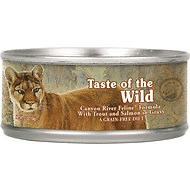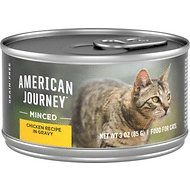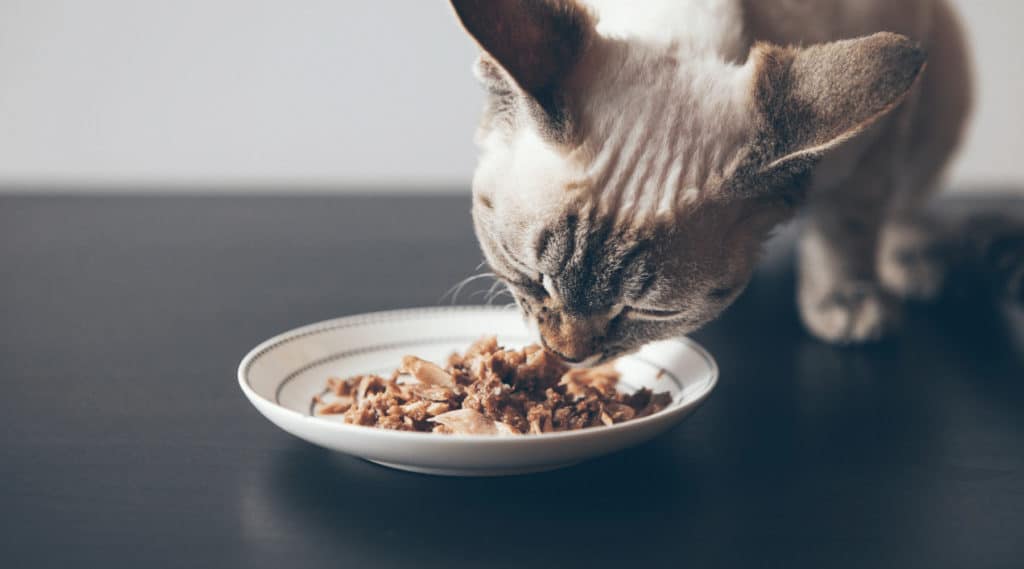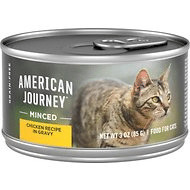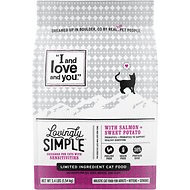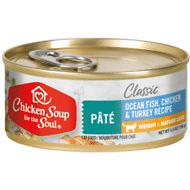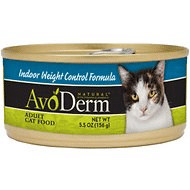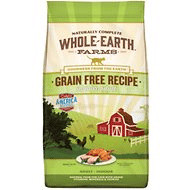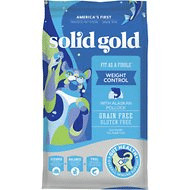Contents
- What is the Best Weight Loss Cat Food?
- The Dangers of Obesity in Cats
- Tips for Helping Your Cat Lose Weight
- Should You Consider Prescription Weight Loss Cat Food?
- How Do We Make Our Recommendations?
- The 9 Best Weight Control Cat Foods
- Smalls Fresh Food Delivery
- Taste of the Wild Canyon River Grain-Free Canned Cat Food
- American Journey Minced Chicken Recipe in Gravy Grain-Free Canned Food
- I and Love and You Lovingly Simple LID Salmon & Sweet Potato Dry Cat Food
- Chicken Soup for the Soul Weight & Mature Care Ocean Fish, Chicken & Turkey Recipe Pate Canned Food
- Blue Buffalo Natural Veterinary Diet W+U Weight Management + Urinary Care Grain-Free Dry Food
- 3 More Top-Rated Cat Foods for Weight Loss
- Frequently Asked Questions
When you see a picture of a tubby cat on Instagram or Facebook, what is your reaction? Do you coo and sigh over the picture, immediately clicking the “share” button? Before you click next time, take a moment to think about what you’re supporting.
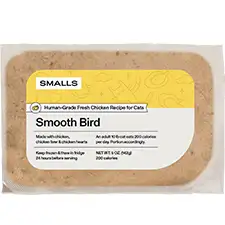
Smalls Human-Grade Ground Bird Fresh Cat Food
- Natural sources of taurine
- High in protein
In recent years, new laws have been passed regarding animal cruelty. If someone is found to be neglecting their pets, not only will the pets be taken away, but the owner might face jail time or hefty fines. Some animal lovers say that this law isn’t enough – that allowing a pet to become obese is a form of neglect and should be considered animal cruelty.
The truth is that some cats are simply meant to be larger than others – the same is true for people. But if you have a Munchkin cat that weighs as much as a Maine Coon, chances are that it isn’t healthy. Obesity in cats is nothing to joke about – it impacts your cat’s health, wellness, and longevity.
In this article, we’ll explore the subject of feline obesity in greater depth. We’ll talk about how cats become overweight and what impact obesity has on a cat’s health. You’ll also learn some simple tips for helping your cat lose weight and see our top 9 picks for the best canned cat food and best dry cat food to help your cat lose weight.
What is the Best Weight Loss Cat Food?
- Smalls Fresh Food Delivery
- Taste of the Wild Canyon River Grain-Free Canned Cat Food
- American Journey Minced Chicken Recipe in Gravy Grain-Free
- I and Love and You Lovingly Simple LID Salmon & Sweet Potato
- Chicken Soup for the Soul Weight & Mature Care Ocean Fish
- Blue Buffalo Natural Veterinary Diet W+U Weight Management
- AvoDerm Natural Indoor Weight Control Formula Adult
- Whole Earth Farms Grain-Free Indoor Chicken & Turkey Adult
- Solid Gold Fit as a Fiddle Weight Control with Alaskan Pollock
The Dangers of Obesity in Cats
Obesity has become a problem of epidemic proportions for humans, but it is becoming increasingly more prevalent among pets as well. According to the Association for Pet Obesity Prevention, an estimated 60% of cats and 56% of dogs are overweight or obese. That equates to roughly 50 million dogs and 56 million cats.
When you hear the word “obesity,” you probably picture someone who is obviously overweight. All of their limbs are larger than average, and they carry a significant amount of weight around their middle. The excess weight makes it difficult for them to walk easily, let alone engage in any form of strenuous exercise, and it may look as if the simple act of existing is a significant drain of their energy. All of these things are on the outside, but there are also likely to be significant healthy issues below the surface.
Obesity in humans is easy to identify, but what about pets? You may be shocked to learn that gaining even one or two pounds above your cat’s ideal weight could negatively impact his health. Think of it this way – if a 150-pound person gains two pounds, it equates to less than 2% of his bodyweight. If your 10-pound cat gains two pounds, it equates to 20% of his bodyweight.
In order for your veterinarian to diagnose your cat with obesity, he will be at least 20% heavier than his optimal body weight. A cat becomes overweight if he is just 10% over his ideal weight. But what are the dangers of overweight and obesity in cats?
Here are some of the dangers related to obesity in cats:
- Being overweight or obese shortens the lifespan of a cat.
- Excess weight places a higher burden on the cat’s bones, joints, ligaments, and tendons which can lead to early arthritis.
- Overweight cats are at risk for high blood pressure and other heart problems.
- Being obese increases a cat’s risk for developing diabetes mellitus.
- Excess fat in the chest and abdomen can restrict the lungs and affect breathing.
- Overweight cats have a higher risk for hepatic lipidosis (fatty liver disease) and urinary problems.
- Being overweight can decrease immune function and cause other health issues.
- Cats that are obese are at a greater surgical risk due to compromised heart and lung function.
Tips for Helping Your Cat Lose Weight
As much as you might feel like you’re depriving your cat by reducing his feeding amount, you’re actually doing him a favor. Obesity is not fun for anyone, and your cat won’t feel well if he is too overweight to live his life in a healthy way. Helping your cat lose weight requires a lot of effort on your part, and you need to stay committed to the task at hand for at least 6 months to achieve your goal.
Here are some simple tips for helping your cat lose weight:
- Weigh your cat and check his weight against the feeding recommendations on the cat food package to see whether you are overfeeding him or not.
- Reduce your cat’s daily portion by feeding him the amount of food recommended for his ideal weight, as long as it won’t cause him to lose weight too quickly.
- If you currently let your cat feed freely, start dividing his daily portion into two distinct meals and limit mealtime to 30 minutes.
- Increase your cat’s activity level by using interactive toys like laser pointers, ribbons, and more.
- Consider feeding your cat with a slow-feed bowl or a puzzle toy to make mealtime more active.
- Be mindful of how many treats you are giving your cat – they should amount to no more than 10% of his daily calories and be used as rewards for activity.
- Give your cat a water fountain – the moving water will be more appealing and drinking more water may help with hunger and digestion.
Helping your cat lose weight is not going to be a quick and easy process. In addition to choosing a good cat food for weight loss, you also need to encourage your cat to be more active. You’ll also need to scale back the number of treats you give your cat. If your cat has a significant amount of weight to lose or concurrent health problems, you might consider a prescription weight loss cat food.
Should You Consider Prescription Weight Loss Cat Food?
A prescription diet for pets is one formulated to address a specific problem and generally requires a veterinarian’s prescription to purchase. You’re probably familiar with some of the top brands of prescription cat food like Hill’s Prescription Diet and Royal Canin Veterinary Diet. Before you spend a small fortune on prescription weight loss cat food, take the time to learn what you’re actually buying.
Before you purchase a bag of cat food, you probably check the label to see what ingredients are used in the product. At least, if you don’t do this already, you definitely should! When you check the ingredients for Royal Canin and Hill’s products, you’ll see a number of problems right away.
For many of these recipes, the first ingredient is an animal by-product or not a source of protein at all. These formulas are very expensive, but they make heavy use of low-quality ingredients and fillers. This leads us to wonder how much the veterinarians who recommend these products actually know about pet nutrition. The problem is that pets tend to love these products. Filled with artificial flavors and other additives to improve taste and palatability, it is no wonder these products are popular with pets but if you took a moment to gauge the product’s quality for yourself, you would put it back on the shelf.
This is not to say that all prescription diets are bad. In fact, there are several brands we heartily recommend, first and foremost, Blue Buffalo Natural Veterinary Diets. These recipes start with a high-quality source of animal protein and they are supplemented with healthy fats, digestible carbohydrates, fresh fruits and vegetables, and beneficial supplements. Below you’ll see our review for the weight management recipe from Blue Buffalo Natural Veterinary Diet.
How Do We Make Our Recommendations?
High-quality nutrition is the best way to support your cat’s long-term health and wellness. Understanding the basics about your cat’s nutritional needs is the best place to start in choosing a healthy diet, but it takes time and practice to learn how to read a cat food label. You’ll be glad to know, then, that we’ve taken the time to check out some of the most popular brands and recipes out there to bring you our top picks.
But how do we make our recommendations? Here are some of the things we look for:
- A source of high-quality animal protein as the first ingredient
- At least 30% crude protein for kittens and at least 26% for adults
- A minimum of 9% crude fat for kittens and adults
- A balance of omega-3 and omega-6 fatty acids, primarily from animal sources
- A rich blend of nutrients from natural sources and supplements, as needed
- Limited carbohydrate content from digestible sources (like whole grains and veggies)
- No low-quality fillers, by-products, or artificial additives (preservatives, dyes, or flavors)
As you start shopping for a new cat food for weight loss, you’ll also want to pay close attention to the calorie content of cat food. Generally speaking, higher fat content is correlated with higher calorie content, so look for something in the 9% to 12% range. Remember too that protein is the most important nutrient and high-protein diets are better for weight loss in cats.
The 9 Best Weight Control Cat Foods
Now that you have a better understanding of obesity in cats and how dangerous it can be, you see the importance of helping your cat achieve and maintain a healthy body weight. Taking our advice into account, you are ready to start shopping around for a good diet cat food. If you’re still not ready to go out on your own, consider one of our top 9 picks for the best weight loss cat foods reviewed below.
Here’s our top pick for the best weight management cat foods:
| Our 2024 Picks: Overall Best Foods for Obesity | |||
Smalls Fresh Cat Food
|
CHECK PRICE | ||
Taste Of The Wild Canyon River Grain-Free
|
CHECK PRICE | ||
American Journey Minced Chicken Recipe
|
CHECK PRICE | ||
I And Love And You Lovingly Simple LID Salmon
|
CHECK PRICE | ||
Chicken Soup For The Soul Weight & Mature Care Ocean Fish
|
CHECK PRICE | ||
Blue Buffalo Natural Veterinary Diet W+U
|
CHECK PRICE | ||
AvoDerm Natural Indoor Weight Control
|
CHECK PRICE | ||
Whole Earth Farms Grain-Free Indoor Chicken
|
CHECK PRICE | ||
Solid Gold Fit As A Fiddle Weight Control With Alaskan
|
CHECK PRICE | ||
Smalls Fresh Food Delivery
Overall Healthy Weight Cat Food: The best diet for an overweight cat is one that supports the cat’s nutritional needs without going overboard on calories. A high-protein, low-carbohydrate diet made with wholesome, highly digestible ingredients is important. That’s where Smalls comes in. This is a brand of fresh pet food that sends deliveries right to your door. You simply provide some information about your cat’s age and weight as well as his body condition, then you’ll be asked about his feeding goals. If your cat needs to lose weight, you simply select that option and Smalls will calculate the ideal number of calories to help your cat achieve his goals and then send you proportioned packages of fresh cat food. There are two recipes to choose from, both made with premium sources of animal protein with fresh fruits and vegetables. To learn more about Smalls’s approach to weight loss in cats, check out this article.
- Pros: Real animal protein first ingredient, customized to your cat’s calorie needs, fresh fruits and vegetables, high-quality natural ingredients, complete and balanced for all life stages
- Cons: Significantly more expensive than average cat food, only two recipes to choose from
Taste of the Wild Canyon River Grain-Free Canned Cat Food
Most Popular Cat Food for Weight Loss: Because there are so many different cat foods out there, it can be tough to choose just one. If you’re not sure where to start looking and you want to make sure your cat gets the nutrients he needs while losing weight, consider this Taste of the Wild Canyon River Grain-Free Canned Cat Food. The Taste of the Wild brand is very popular because they use premium-quality animal proteins in highly digestible recipes formulated for complete and balanced nutrition. This particular recipe is fairly low in calories but very high in protein with limited carbohydrate content. Measured as dry matter, it contains 44% protein and 16.6% fat at 79 calories per 3-ounce can or 145 calories per 5-ounce can.
- Pros: Rich in real animal protein, blend of omega-3 and omega-6 fatty acids, limited calorie and fat content, complete and balanced, rich in dietary fiber, chelated mineral supplements
- Cons: Not specifically formulated for weight loss, main source of fat is plant-based (sunflower oil)
American Journey Minced Chicken Recipe in Gravy Grain-Free Canned Food
Most Affordable Cat Food for Weight Loss: The quality of your cat’s diet is extremely important, but there is no reason you need to pay a fortune for a decent cat food. If you’re looking for a recipe that is affordable and will work well with your cat’s weight loss goals, consider this American Journey Minced Chicken Recipe in Gravy Grain-Free Canned Food. This formula features fresh chicken as the main ingredient with both chicken and turkey broth as natural sources of flavor and moisture. There is limited carbohydrate content, primarily from peas, cranberries, and blueberries, which also act as natural sources for key vitamins and minerals. This recipe contains 50% protein and 22% fat as dry matter with just 76 calories per 3-ounce can.
- Pros: Real chicken first ingredient, affordable price, rich in moisture and natural flavor, fresh fruits and veggies, complete and balanced, chelated mineral supplements
- Cons: May be a little high in fat, not specifically designed for weight loss
I and Love and You Lovingly Simple LID Salmon & Sweet Potato Dry Cat Food
Weight Loss and Sensitive Stomach: Helping your cat lose weight becomes even more of a challenge when he has a sensitive stomach. If your cat is sensitive to grains or certain proteins, you may find yourself at a loss for what to feed him. We recommend this I and Love and You Lovingly Simple LID Salmon & Sweet Potato Dry Cat Food because it contains a limited number of ingredients and a lower than average calorie content. This recipe features fresh salmon and menhaden fish meal as the top two ingredients, both rich sources of protein and healthy fats. It also contains digestible grain-free carbohydrates like sweet potatoes, chickpeas, and peas with a number of beneficial supplements to ensure complete and balanced nutrition. It may not be specifically formulated for weight loss, but it is rich in protein and vital nutrients.
- Pros: Real animal protein as top two ingredients, limited number of main ingredients, rich in protein (36%), digestible grain-free carbohydrates, vitamin and chelated mineral supplements
- Cons: Not specifically formulated for weight loss, higher in fat than some weight loss recipes
Chicken Soup for the Soul Weight & Mature Care Ocean Fish, Chicken & Turkey Recipe Pate Canned Food
Best Canned Cat Food for Weight Loss: Because canned food tends to be higher in protein and moisture than dry food, it makes a great choice for cats who need to lose weight. Our top pick for the best diet wet cat food is Chicken Soup for the Soul Weight & Mature Care Ocean Fish, Chicken & Turkey Recipe Pate Canned Food. This recipe features fresh ocean fish as the first ingredient with chicken, chicken liver, eggs, salmon, turkey, and duck as supplemental sources of protein. When measured as dry matter, this recipe contains 41% crude protein and 13.6% fat. Not only is it very high in protein with limited fat content, but it is low in calories as well. This recipe contains no corn, wheat, or soy ingredients and it is complete and balanced to ensure optimal nutrition for your cat.
- Pros: Rich in real animal protein, low in calories, digestible whole-grain carbohydrates, fresh fruits and vegetables, chelated mineral supplements, supports healthy weight loss
- Cons: Main source of fat is plant-based (flaxseed), contains some cellulose (difficult to digest)
Blue Buffalo Natural Veterinary Diet W+U Weight Management + Urinary Care Grain-Free Dry Food
Best Prescription Weight Loss Cat Food: If your cat is significantly overweight or suffering from additional health problems, you might want to consider a prescription diet. Our pick for the best prescription weight loss cat food is Blue Buffalo Natural Veterinary Diet W+U Weight Management + Urinary Care Grain-Free Dry Food. This recipe features fresh chicken as the first ingredient with chicken meal immediately following it. Chicken fat and flaxseed provide a balance of omega-3 and omega-6 fatty acids with a total crude fat content of just 11%. This formula is very rich in protein at 38% and contains a variety of fresh fruits and vegetables to contribute key nutrients. As a prescription diet, this recipe also contains increased levels of fiber to help with satiety and it contains ideal levels of calories and fat to help with weight loss.
- Pros: Formulated for healthy weight loss, rich in protein, low in fat and calories, real chicken first ingredient, fresh fruits and vegetables, probiotics, no artificial additives or by-products
- Cons: Significantly more expensive than average cat food, contains some plant protein (pea protein)
3 More Top-Rated Cat Foods for Weight Loss
The six cat food recipes reviewed above are all excellent options. We chose them for specific reasons to help you make the right choice if your cat is dealing with additional issues on top of being overweight. If you’re simply looking for a good cat food for weight loss and your cat doesn’t have any special dietary needs, the following 3 cat foods might work well:
AvoDerm Natural Indoor Weight Control Formula Adult Canned Food
Generally speaking, canned food is a good option for cats who need to lose weight because it tends to be high in protein and low in carbohydrates. We recommend this AvoDerm Natural Indoor Weight Control Formula Adult Canned Food as an option because it contains 36% protein (as dry matter) and it is highly digestible. Because it has a lower calorie content with plenty of fiber, this recipe is ideal for indoor cats who need to lose weight. It is also complete and balanced thanks to the inclusion of vitamin and chelated mineral supplements. Overall, it is a protein-rich, low-calorie option for cats.
- Pros: Rich in animal protein, low-calorie formula for weight loss, complete and balanced nutrition, rich in real meat flavor, chelated mineral supplements, fresh fruits and veggies
- Cons: May be too high in fat for some cats
Whole Earth Farms Grain-Free Indoor Chicken & Turkey Adult Recipe Dry Cat Food
If you’re concerned that your cat’s current diet is making him gain weight, consider switching to this Whole Earth Farms Grain-Free Indoor Chicken & Turkey Adult Recipe Dry Cat Food. This recipe is uniquely formulated for indoor cats, so it is higher in fiber and lower in calories than many cat foods. Plus, it features real chicken as the main ingredient with turkey meal, chicken, turkey, and salmon meal as supplemental sources of protein. This recipe is complete and balanced with the addition of essential vitamins and chelated minerals, providing 32% protein and 10% fat at 352 calories per cup.
- Pros: Formulated for indoor cats, high in fiber, low in calories and fat, rich in animal protein, complete and balanced nutrition, probiotic supplements, chelated mineral supplements
- Cons: Could be a little higher in protein content, some protein comes from plants (peas & alfalfa meal)
Solid Gold Fit as a Fiddle Weight Control with Alaskan Pollock Grain-Free Adult Dry Food
For cats who need to lose weight, a formula designed specifically for weight loss could be a good choice. We recommend this Solid Gold Fit as a Fiddle Weight Control with Alaskan Pollock Grain-Free Adult Dry Food because it is a holistic, natural recipe featuring high-quality ingredients. This recipe is made with fresh-caught Alaskan pollock as well as 16 nutrient-dense superfoods that provide the ideal blend of vitamins, minerals, antioxidants, fiber, and more to support your cat’s digestion, immunity, and overall health. This recipe contains 31% crude protein with just 9% fat and 360 calories per cup.
- Pros: Formulated for healthy weight loss, rich in animal protein, holistic natural recipe, high-quality ingredients, fresh fruits and vegetables, rich in antioxidants and fiber, complete and balanced nutrition
- Cons: Could be a little higher in protein content
Frequently Asked Questions
- How do I get my indoor cat to lose weight? – Indoor cats are often fed very energy-dense diets made with a significant amount of carbohydrates. This is problematic for a number of reasons. First and foremost, cats are obligate carnivores which means that protein is the most important nutrient and the carbohydrate content of their diet should be limited. Second, indoor cats tend to be much less active than outdoor cats, so an energy-dense diet might provide way more calories than an indoor cat needs – this is a recipe for weight gain. If you’re looking cat food for overweight indoor cats, choose something that is higher in protein and lower in carbohydrates with limited fat content to control calories.
- Is wet or dry cat food better for weight loss? – If you’re wondering whether to feed your cat dry food or low calorie wet cat food, there is not just one right answer. A high-quality dry cat food that contains premium animal proteins with limited fat and calorie content can be just as beneficial for weight loss as the best diet wet cat food. According to Feline Nutrition, the best diet for weight loss in cats is a high protein, low carbohydrate diet – we’re talking 45% crude protein or higher. The important thing to note here is that most cat foods that contain more than 40% protein tend to be canned foods, so wet food might be the best option to help your cat lose weight unless you find a dry food that meets the same requirements.
- How long does it take a cat to lose weight? – The amount of time it takes your cat to lose weight depends on several factors. First and foremost, it depends on the amount of weight the cat needs to lose as well as what and how much you are feeding him. Generally speaking, you can expect it to take 6 to 8 months for your cat to achieve his ideal weight. If it is taking longer, you may need to make an adjustment and should contact your veterinarian. Just remember that your cat should be losing no more than 1 pound per month.
- How much should I feed my cat? – How much you feed your cat varies depending on the type of food you’re feeding him. Every cat food is different in terms of calorie content, so you’ll need to refer to the feeding instructions on the package. Whether you choose a low calorie wet cat food or a dry cat food, pay attention to those instructions and follow them carefully according to the advice provided above.
- How many times a day should a cat eat? – Most cats do well with two meals per day, though you may need to make adjustments in certain cases. If you have a growing kitten, he may need three meals per day or more. As an adult, however, the concern becomes maintaining a healthy body weight rather than supporting weight gain and healthy development. As long as you choose a low calorie cat food and pay attention to the feeding recommendations, your cat should do just fine with two meals per day.
The number of fat cats on the Internet contributes to the idea that overweight pets are cute when nothing could be further from the truth. Obesity is not funny or cute, no matter who it affects. If your cat is very overweight, it could be affecting his health and might even take years off his lifespan.
If you want what’s best for your furry friend, you need to buckle down and take responsibility for doing your job as a cat owner. Start feeding your cat a better diet and monitor his portions to help him lose weight. If you’re not sure what to choose, try one of our top picks reviewed above.

